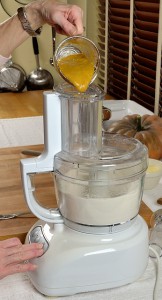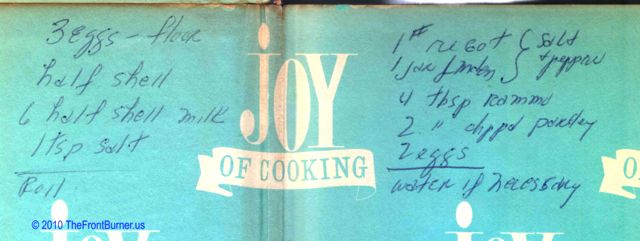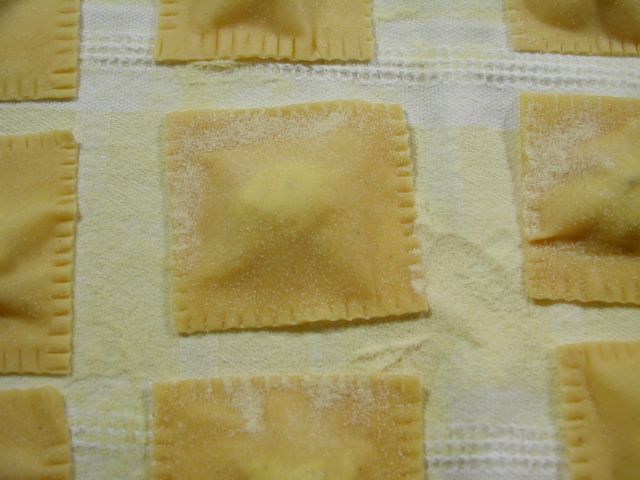Topic Index
The font size for a topic word is sized by the number of articles that reference that topic. The more articles the bigger the font.
Click on a word to search for posts with that topic. This page will reload with the search results.
Pumpkin Lasagne ai Quattro Formaggi
Pumpkin Lasagna with Four Cheeses
This one needs a Family Tree. So here goes. I have been a fan of Domenica Marchetti for quite some time. Lucky me, I won a copy of her newest book, The Glorious Pasta of Italy from Paula Yoo of Write Like You Mean It. (Great name, Paula. Great site.) I had just begun to give the book some serious reading when David Leite of Leite’s Culinaria included Domenica’s recipe for Pumpkin Lasagne in his Weekly Update. (If you do not already subscribe, sign up for a wealth of information.) And as if I needed any more convincing, Kathy included the recipe in her Food Lover’s Odyssey (another site not to be missed) Top 10 Italian Recipes from Around the Web. See what I mean about the Family Tree?
I had been looking for something different for a first course for Thanksgiving when the Pumpkin Lasagne recipe caught my eye. Lasagna, why not? What surprised me was that the pumpkin puree is in the pasta, not between the layers. By the way – don’t be thrown by lasagne ending with an “e”. The name of this recipe refers to the multiple sheets of pasta known individually as lasagna. The final “a” of Italian feminine nouns changes to “e” in the plural. Mystery solved. Read the remainder of this entry »
My Calabria by Rosetta Costantino with Janet Fletcher
A Book Review

My Calabria: Rustic Family Cooking from Italy’s Undiscovered South
I have mentioned it before. I am a cookbook addict, an avid collector. I love the genre, and my shelves are overflowing. Positively, absolutely overflowing. The truth is the books have begun a slow walk across the library floor, down the hall to the side of my bed. Ask anyone who knows me, and they’ll tell you. It is only fitting that the books have made their way to my bedside since cookbooks are my preferred bedtime reading. But with all those books I have had to become highly selective with my purchases. This one, however, was the proverbial no brainer. As soon as I heard that Rosetta Costantino had written a book on the cooking of Calabria, I knew I had to buy it. Ms. Costantino was born in Calabria, and at the age of fourteen came with her parents to the United States. She and her family live in Oakland, California where she teaches cooking. Her book was released late last year. I apologize to you all for keeping it to myself. Its 416 pages are filled with the food and culture of Calabria, all from the very personal viewpoint of Ms. Costantino. This collection of recipes, reminiscences and cultural background will have you reaching for your Post-It Flags. Read the remainder of this entry »
Mom’s Ravioli: Part One – Old Cooks and Old Recipes
That is the Crocetti Family Ravioli recipe in its entirety as my grandmother, Angela Barra Crocetti, (known as Mom) dictated it to my mother, Josephine. My mother, known to all who loved her as Jeff, transcribed the recipe in the endsheet of her 1962 edition of the American classic, Joy of Cooking. There are no other directions. This recipe assumes a level of proficiency that any good Italian girl would have achieved by the age of fourteen. One of my fondest memories of Mom was sitting at the kitchen table in her home on Inglewood Boulevard in Los Angeles with the sunlight streaming in over my left shoulder. I remember it as though it were yesterday. Mom placed her spianatoia (wooden pastry board) on her kitchen table. She scooped a mountain of flour onto her board, dug a well in the center and into that well she cracked the eggs. In went the salt. Now it was time for the milk. Yes, the milk. I know. Well, back then I didn’t. Most pasta recipes, if they call for any liquid other than eggs will call for olive oil or water. But some Italian cooks often use milk for their filled pastas. And she measured that milk in the most charming fashion, in the half shell of a cracked egg. No need for a measuring cup. This was Italian home cooking from the ground up. She made but one concession to the modern age, but more on that later. She took her fork and began to beat the eggs, salt and milk in her well. As she agitated the ingredients she brought in the flour, bit by bit, incorporating it until she had a shaggy mass. Down went the fork, up went her sleeves, and she began to knead the big mass of dough. After about ten minutes she was satisfied with her supple dough. I was amazed. She covered it with a kitchen towel and we went into her sewing room.
After about half an hour we returned to the kitchen to form the ravioli. Mom cut the dough not with a fancy rolling cutter, but with a kitchen knife. She covered what she was not going to use right away, picked up her extra long matterello (rolling pin) and began to work her brand of wizardry on the dough. Back and forth she moved her matterello, coaxing the dough to an ever greater size and greater degree of thinness. To my child’s eye it looked like magic. She rolled over the dough and out to the edge farthest from her, then rolled that far edge of dough over her matterello pulling it back to her, rolling and gathering the dough around it as she worked, sliding her floured hands across the dough-covered tool, stretching it with her hands, then rolling it out to the far edge again. She gave the dough a quarter turn and repeated the process. Over and over. The dough she rolled was gorgeous, so thin I could see the shadow of her hand behind it as she lifted and turned it. Alchemy. And the sound of the dough on the board, sort of a “shh-shh.” Her pasta dough was light, yet strong enough to form into ravioli that kept its integrity when boiled. And that is where I came in. I was responsible for crimping the edges of the chicken and cheese packets she assembled. I used a fork to crimp the edges all the way around, the perfect job for a little girl, the initiation to the women’s kitchen. I remember being so proud when we were finished. It made eating the treasures all the more enjoyable. Remembering those days in her kitchen and looking at the recipe now I am astonished by the economy of tools, not to mention verbiage. No fancy rolling cutter, no Atlas machine, no KitchenAid pasta roller, no measuring cups. In fact, I doubt if she used a teaspoon to measure the salt.
When I was in my twenties I became an altogether obsessive cook, I wanted detail. I needed to know absolutely everything. Ah, if only I had been born into the era of recipes accompanied by step-by step photography. But no, I was taught by cooks who said things like “When it is the right consistency, pour the batter into a pan. Bake in a fast oven until done.” WHAT!! Good grief! What was I supposed to do? Obsessive young woman that I was I wanted particulars. For many years I was utterly constrained by obsessiveness. Ask my friends. They’ll tell you. If a recipe called for 1 1/4 teaspoons of vanilla extract and I had only 1 teaspoon, I did not make the dish. Period. Time has passed, and I now embrace improvisation. I enjoy being one of those cooks who can play in the kitchen and make do with what she has. My Italian forebears made do because they had to. Making do with what one has in one’s pantry is the hallmark of la cucina casareccia (home cooking), la cucina povera (the cooking of the poor.) I am writing this post to tell all of you not to wait until you are my age to feel free in the kitchen. Try new things. Look at the recipes you see here and elsewhere and make them your own. Build on your fundamentals toward a cuisine all your own. And take notes! Let me know what you have tried. I would love to hear from you.
Coming up… Part Two – Making the Ravioli



